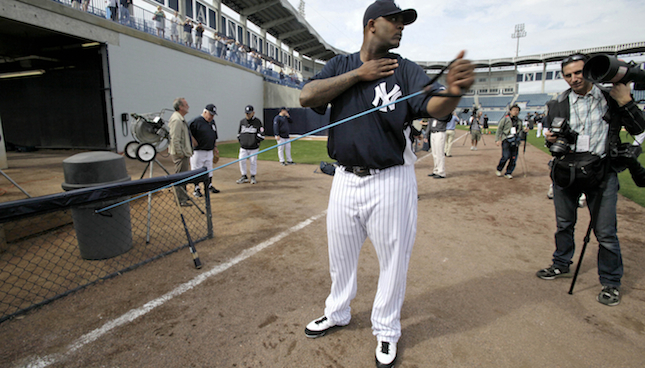The Ultimate Pitcher’s Warm-Up: 4 Shoulder Exercises with Bands

AP Images
Look inside any pitcher’s game bag and you’re almost guaranteed to find two things: sunflower seeds and stretch bands. While the performance-enhancing effects of sunflower seeds are questionable, stretch bands can be valuable warm-up tools when they’re used properly.
Bands are the standard for “arm care,” which usually means doing shoulder exercises with bands for dozens of high-rep sets. Movements like internal and external rotations can be useful, but unfortunately, players frequently butcher the form or do so many reps they’re tired when they take the mound.
Warm-up with a purpose
A pitcher’s upper-body warm-up should:
- Activate the rotator cuff
- Get the arm overhead safely
- Mobilize tight muscles/connective tissues
- Sync up the movements of the humerus (upper arm) and scapula (shoulder blade)
- Not cause fatigue
These four shoulder exercises with bands will get you warmed up and ready to throw heat without making you feel like you just competed in a world championship arm wrestling contest.
Band Pull-Aparts
BPAs are one of the best exercises for improving posture. They also get the scapula working in unison with the humerus. The shoulder is a ball-and-socket joint. When you move your arm, some of the movement occurs from the ball gliding in the socket, and some comes from repositioning of the scapula. This is called glenohumeral rhythm. BPAs sync the timing of the rotator cuff and scapular stabilizers.
How to:
- Stand tall with your abs and glutes tight, keeping a flat back.
- Hold a band at arm’s length straight out with your palms down and hands shoulder-width apart.
- Pull your hands away from each other and stretch the band toward your chest, moving your arms before you pinch your shoulder blades together.
- Stop when the band is at your chest and your arms are straight out to the sides.
- Pause for a second; take care not to drive the scapulae “down and back” too aggressively.
Half-Kneeling Band Overhead Shrugs
Shrugs get a bad rap in many strength and conditioning circles. Untrained people often have weak lower traps, prompting coaches to cue the shoulders “down and back” rather than in a shrugged position. But the upper traps play a key role in rotating the scapula upward and getting the arm safely overhead.
Use the Overhead Band Shrug to help you get to your arm slot. The half-kneeling position stretches the hips, keeps the spine neutral and gets the core muscles firing.
How to:
- Get in a lunge stance with your non-throwing-side foot forward.
- Loop a band under your back foot.
- Grab the band with your throwing hand and raise your arm overhead.
- Squeeze your abs and glutes, make a double chin to keep your head from poking forward and “punch” toward the ceiling to shrug the throwing shoulder.
Forearm Wall Slides with Band
When you pitch, your shoulder internally rotates at insane speeds—up to 7,000 degrees per second. The front of the shoulder works hard to create that movement, but the back of the shoulder has to work even harder to decelerate the movement. The external rotators of the shoulder work eccentrically (i.e., lengthening under tension) to slow down the arm during the follow-through, and Forearm Wall Slides get the external rotators fired up to do the job.
Forearm Wall Slides activate the lower traps, turn on the core and stabilize the shoulder blades. By adding a band around your wrists, you pull your shoulders into internal rotation, forcing the external rotators to fire and resist the movement. This jumpstarts the muscles that decelerate the throwing arm for a safer delivery.
How to:
- Wrap a light band around your wrists and bend your arms and elbows at 90 degrees as if you were doing a Plank.
- Place your forearms against a wall and stand up straight, keeping your chin tucked and abs and glutes tight.
- Gently pull your hands apart to keep tension on the band—don’t let the band pull your hands toward each other.
- Slowly slide your forearms up the wall until your arms are nearly straight, making sure not to overarch your lower back.
- Slide back down the wall, pulling the band apart the whole time.
Half-Kneeling Face Pull with External Rotation
External rotation (ER) at the shoulder is a double-edged sword when it comes to pitching. You need lots of ER range of motion to get the throwing arm to “lay back” and create whip for extra velocity. But the more you throw, the more ER you get, which can lead to looseness in the front of the shoulder. That said, pitchers should never stretch into ER, and they don’t need to mobilize their external rotators with band shoulder exercises—just playing catch does the job.
Plus, most pitchers use such terrible form during band ERs that they do more harm than good. Overarching the lower back, poking the head forward, shrugging the shoulders and “yanking” into ER are all common mistakes.
The Half-Kneeling Face Pull with External Rotation keeps the core engaged and lets the shoulder function properly. The external rotators are small muscles, so the Face Pull reduces the effort needed to get into an externally rotated position.
How to:
- Take a split stance with your abs and glutes tight.
- Hold a band at face level with your palms down and thumbs facing you.
- Pull the band toward your face, keeping your hands above your elbows, then externally rotate as if making a field goal post with your arms.
- When your hands are by your ears, slowly lower them toward the floor, keeping your elbows and shoulders stationary.
- This works the external rotators eccentrically, which is exactly how they work when decelerating the arm during a pitch.
Pulling it all together
Perform the following circuit as part of a full body warm-up prior to throwing.
1A. BPAs: 10-12 reps
1B. Half Kneeling Band Overhead Shrugs: 10-12 reps (throwing arm side), 8-10 reps (non-throwing side)
1C. Forearm Wall Slides with Band: 8-10 reps
1D. Half-Kneeling Face Pull with External Rotation: 8-10 reps (throwing arm side), 6-8 reps (non-throwing side)
Perform these exercises in order with 30 seconds rest between. Rest 60 seconds between circuits and repeat the circuit 2 or 3 times, as needed. Don’t use too much band tension—just enough that you could do twice as many reps if necessary. The goal is to mobilize and activate, not fatigue.
Read More:
[cf]skyword_tracking_tag[/cf]RECOMMENDED FOR YOU
MOST POPULAR
The Ultimate Pitcher’s Warm-Up: 4 Shoulder Exercises with Bands

AP Images
Look inside any pitcher’s game bag and you’re almost guaranteed to find two things: sunflower seeds and stretch bands. While the performance-enhancing effects of sunflower seeds are questionable, stretch bands can be valuable warm-up tools when they’re used properly.
Bands are the standard for “arm care,” which usually means doing shoulder exercises with bands for dozens of high-rep sets. Movements like internal and external rotations can be useful, but unfortunately, players frequently butcher the form or do so many reps they’re tired when they take the mound.
Warm-up with a purpose
A pitcher’s upper-body warm-up should:
- Activate the rotator cuff
- Get the arm overhead safely
- Mobilize tight muscles/connective tissues
- Sync up the movements of the humerus (upper arm) and scapula (shoulder blade)
- Not cause fatigue
These four shoulder exercises with bands will get you warmed up and ready to throw heat without making you feel like you just competed in a world championship arm wrestling contest.
Band Pull-Aparts
BPAs are one of the best exercises for improving posture. They also get the scapula working in unison with the humerus. The shoulder is a ball-and-socket joint. When you move your arm, some of the movement occurs from the ball gliding in the socket, and some comes from repositioning of the scapula. This is called glenohumeral rhythm. BPAs sync the timing of the rotator cuff and scapular stabilizers.
How to:
- Stand tall with your abs and glutes tight, keeping a flat back.
- Hold a band at arm’s length straight out with your palms down and hands shoulder-width apart.
- Pull your hands away from each other and stretch the band toward your chest, moving your arms before you pinch your shoulder blades together.
- Stop when the band is at your chest and your arms are straight out to the sides.
- Pause for a second; take care not to drive the scapulae “down and back” too aggressively.
Half-Kneeling Band Overhead Shrugs
Shrugs get a bad rap in many strength and conditioning circles. Untrained people often have weak lower traps, prompting coaches to cue the shoulders “down and back” rather than in a shrugged position. But the upper traps play a key role in rotating the scapula upward and getting the arm safely overhead.
Use the Overhead Band Shrug to help you get to your arm slot. The half-kneeling position stretches the hips, keeps the spine neutral and gets the core muscles firing.
How to:
- Get in a lunge stance with your non-throwing-side foot forward.
- Loop a band under your back foot.
- Grab the band with your throwing hand and raise your arm overhead.
- Squeeze your abs and glutes, make a double chin to keep your head from poking forward and “punch” toward the ceiling to shrug the throwing shoulder.
Forearm Wall Slides with Band
When you pitch, your shoulder internally rotates at insane speeds—up to 7,000 degrees per second. The front of the shoulder works hard to create that movement, but the back of the shoulder has to work even harder to decelerate the movement. The external rotators of the shoulder work eccentrically (i.e., lengthening under tension) to slow down the arm during the follow-through, and Forearm Wall Slides get the external rotators fired up to do the job.
Forearm Wall Slides activate the lower traps, turn on the core and stabilize the shoulder blades. By adding a band around your wrists, you pull your shoulders into internal rotation, forcing the external rotators to fire and resist the movement. This jumpstarts the muscles that decelerate the throwing arm for a safer delivery.
How to:
- Wrap a light band around your wrists and bend your arms and elbows at 90 degrees as if you were doing a Plank.
- Place your forearms against a wall and stand up straight, keeping your chin tucked and abs and glutes tight.
- Gently pull your hands apart to keep tension on the band—don’t let the band pull your hands toward each other.
- Slowly slide your forearms up the wall until your arms are nearly straight, making sure not to overarch your lower back.
- Slide back down the wall, pulling the band apart the whole time.
Half-Kneeling Face Pull with External Rotation
External rotation (ER) at the shoulder is a double-edged sword when it comes to pitching. You need lots of ER range of motion to get the throwing arm to “lay back” and create whip for extra velocity. But the more you throw, the more ER you get, which can lead to looseness in the front of the shoulder. That said, pitchers should never stretch into ER, and they don’t need to mobilize their external rotators with band shoulder exercises—just playing catch does the job.
Plus, most pitchers use such terrible form during band ERs that they do more harm than good. Overarching the lower back, poking the head forward, shrugging the shoulders and “yanking” into ER are all common mistakes.
The Half-Kneeling Face Pull with External Rotation keeps the core engaged and lets the shoulder function properly. The external rotators are small muscles, so the Face Pull reduces the effort needed to get into an externally rotated position.
How to:
- Take a split stance with your abs and glutes tight.
- Hold a band at face level with your palms down and thumbs facing you.
- Pull the band toward your face, keeping your hands above your elbows, then externally rotate as if making a field goal post with your arms.
- When your hands are by your ears, slowly lower them toward the floor, keeping your elbows and shoulders stationary.
- This works the external rotators eccentrically, which is exactly how they work when decelerating the arm during a pitch.
Pulling it all together
Perform the following circuit as part of a full body warm-up prior to throwing.
1A. BPAs: 10-12 reps
1B. Half Kneeling Band Overhead Shrugs: 10-12 reps (throwing arm side), 8-10 reps (non-throwing side)
1C. Forearm Wall Slides with Band: 8-10 reps
1D. Half-Kneeling Face Pull with External Rotation: 8-10 reps (throwing arm side), 6-8 reps (non-throwing side)
Perform these exercises in order with 30 seconds rest between. Rest 60 seconds between circuits and repeat the circuit 2 or 3 times, as needed. Don’t use too much band tension—just enough that you could do twice as many reps if necessary. The goal is to mobilize and activate, not fatigue.
Read More:
[cf]skyword_tracking_tag[/cf]









